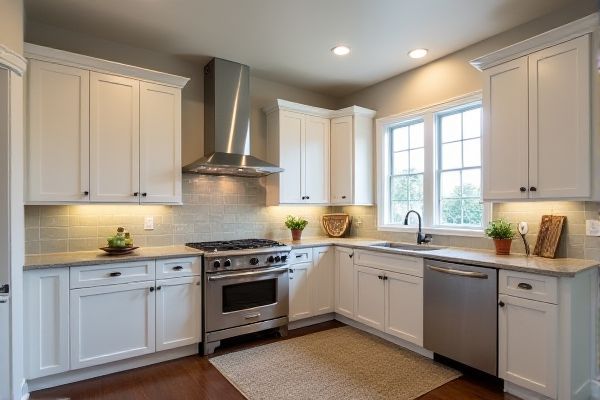
Ceiling-height cabinets maximize vertical storage space, creating a sleek and seamless kitchen appearance while reducing dust accumulation on top of the cabinets. Discover which cabinet height best suits your kitchen design and lifestyle needs by reading the rest of the article.
Table of Comparison
| Feature | Ceiling-Height Cabinets | Standard-Height Cabinets |
|---|---|---|
| Height | Extend from floor to ceiling (8-9 feet) | Typically 30-42 inches tall |
| Storage Capacity | Maximized vertical storage, ideal for large kitchens | Less storage, suitable for smaller spaces |
| Design Impact | Creates sleek, uniform look, minimizes dust on top | Traditional appearance with space above cabinets |
| Installation Cost | Higher due to size and complexity | Lower, more common and easier to install |
| Accessibility | Upper shelves may require step stool | Easier access, shelves at reachable height |
| Cleaning & Maintenance | Less dust accumulation on tops | Requires frequent cleaning above cabinets |
| Resale Value | Can increase home value due to modern look | Standard, less impact on value |
Introduction to Cabinet Height Choices
Ceiling-height cabinets maximize vertical storage space by extending from the floor to the ceiling, offering a sleek, custom look that minimizes dust collection on top surfaces. Standard-height cabinets, typically 30 to 42 inches tall, provide more accessible storage and are often easier to install and modify. Your choice depends on kitchen dimensions, storage needs, and aesthetic preferences, balancing functionality with design impact.
Defining Ceiling-Height vs Standard-Height Cabinets
Ceiling-height cabinets extend from the countertop or base cabinet all the way up to the ceiling, typically measuring about 84 to 96 inches, maximizing storage space in the kitchen. Standard-height cabinets usually stop 12 to 18 inches below the ceiling, ranging from 30 to 42 inches high, allowing room for crown molding or decorative finishes. Choosing between ceiling-height and standard-height cabinets affects both kitchen aesthetics and functional storage capacity.
Aesthetic Impact on Kitchen Design
Ceiling-height cabinets create a sleek, seamless look that visually expands your kitchen by eliminating the gap between cabinets and ceiling. Standard-height cabinets often leave open space above, which can make the room feel smaller and cluttered. Choosing ceiling-height cabinets enhances the modern aesthetic and maximizes storage, elevating your kitchen's overall design appeal.
Storage Capacity Comparison
Ceiling-height cabinets offer significantly increased storage capacity by extending from the floor to the ceiling, utilizing vertical space that standard-height cabinets leave unused. Standard-height cabinets typically measure 30 to 42 inches tall, while ceiling-height options can reach up to 96 inches, providing up to 30%-40% more storage volume. This extra space is ideal for storing seldom-used items or seasonal kitchenware, making ceiling-height cabinets a more efficient solution for maximizing kitchen storage.
Accessibility and Ease of Use
Ceiling-height cabinets maximize vertical storage space, reducing clutter and enhancing kitchen organization by keeping less frequently used items out of daily reach. Standard-height cabinets offer easier access for most users, minimizing the need for step stools and promoting convenience during everyday tasks. Choosing between the two depends on balancing optimal storage capacity with accessibility tailored to user height and kitchen layout.
Installation Considerations
Ceiling-height cabinets require precise measurement and alignment to ensure a seamless fit between the cabinetry and ceiling, often involving custom adjustments for uneven ceilings. Standard-height cabinets are easier to install due to their uniform size and are compatible with most wall heights without additional modifications. When planning your kitchen layout, choosing ceiling-height cabinets demands more time and skill during installation but offers a sleek, built-in appearance with maximized storage space.
Cleaning and Maintenance Differences
Ceiling-height cabinets reduce dust accumulation and simplify cleaning by eliminating the open space above, which often collects grime on standard-height cabinets. Their seamless design minimizes hard-to-reach areas, making maintenance more efficient and less time-consuming. Your kitchen will benefit from easier upkeep and a tidier appearance with ceiling-height options.
Cost Implications
Ceiling-height cabinets generally incur higher costs due to increased material usage and additional labor for installation compared to standard-height cabinets. The added height provides extra storage space, which can justify the investment by maximizing your kitchen's functionality. Budgeting for ceiling-height cabinets should also consider potential expenses for customized trimming and modifications to fit existing ceiling dimensions.
Best Scenarios for Each Cabinet Type
Ceiling-height cabinets are ideal for maximizing storage in kitchens with high ceilings, providing a seamless look and reducing dust collection on top of cabinets. Standard-height cabinets work best in kitchens with lower ceilings or where budget constraints and easier installation are priorities. Your choice depends on balancing available space, aesthetic preferences, and storage needs to optimize kitchen functionality.
Final Decision: Which Cabinet Height Is Right for You?
Ceiling-height cabinets maximize storage by extending all the way to the ceiling, ideal for kitchens with high ceilings and for those who want to utilize every inch of space efficiently. Standard-height cabinets offer easier access without the need for step stools, making them a practical choice for everyday use and smaller kitchens. Your final decision should consider kitchen dimensions, storage needs, and personal convenience to select the cabinet height that best fits your lifestyle.
 homyna.com
homyna.com